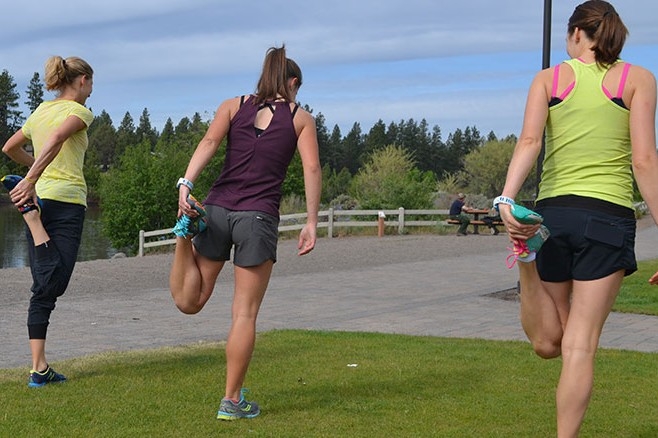Warm-ups should be dynamic... AND fun!

As springtime approaches and the days become longer, many of us take our workouts from inside to the great outdoors. Whether you enjoy walking, biking, hiking, running or any other activity (how about unicycling?), it’s important to know how to warm up properly. This is especially true if you have had a sedentary winter and are just getting back into a workout routine, as you can have soreness and/or pain from doing too much too soon.
As a physical therapist, I am often educating my patients on the importance of stretching. Most people know that stretching is important, but HOW to stretch is the biggest piece to keeping you healthy. I am often asked if stretching should be performed before or after exercise, and the answer is – BOTH! But your type of stretching will be different before versus after exercise.
Back in the day, it was often taught that holding stretches for 30 seconds or more was the most effective way to warm up. This time of stretching is called static stretching. Over the last few years, the literature has shown that static stretching actually increases your risk of injury if performed before exercise. This is because it reduces the amount of strength and force that a muscle can produce and essentially turns the muscles off that you’re asking to work when you exercise! You don’t want to make your muscles sleepy before asking them to work.
Before you exercise, it’s important to perform dynamic stretching. Stretches that are held for 10 seconds or less are considered to be dynamic. By performing quicker and less intense stretches, the body is better prepared for movement and this also reduces your risk of injury. The literature has found that dynamic stretches better prepare you by increasing the oxygen delivery to the muscles, improving your reaction time, and increasing how fast your muscles are contracting. This will get your body ready for dynamic movements that you are about to partake in when you are exercising.
So how does one dynamically stretch? We at PT 360 often teach our patients depending on what activity you want to partake in and tailor it to you. If you’re a gymnast, some of your warmup should be on your hands because that’s what you do in your sport. If you’re a wrestler, there should be a warmup that involves being on the ground, because that’s where your sport is performed! If you’re looking to up your walking or running game, then most of your warmup should be done in standing.
Here are some examples of dynamic warmups that you can easily do either walking, standing in place, or jogging:
- Knee hugs: bring one knee to your chest and squeeze it tight towards your chest so your hip flexes. Hold 2 seconds and then do on the other leg. This will warm up your hip flexors and knees.
- Butt kicks: Bend your knee behind you and kick towards your bottom. This warms your hamstrings.
- Heel taps: bend your knee and rotate your hip so that one foot crosses the front of your body. Reach with your opposing hand. This warms up your hip rotators and glutes
- Side steps: Face one direction and step sideways, keeping your feet straight forward. This warms your hip abductors/glute muscles as well
Dynamic stretches also can be done for the upper body if your sport is racquetball, tennis, pickleball or any other upper body dominant sports.
Static stretches should be done after exercise and held for 30 seconds. This allows the body to properly cool down and rest, which is what we all want after our workout is over!
Happy (almost) spring and enjoy stretching in a safe and effective way!


